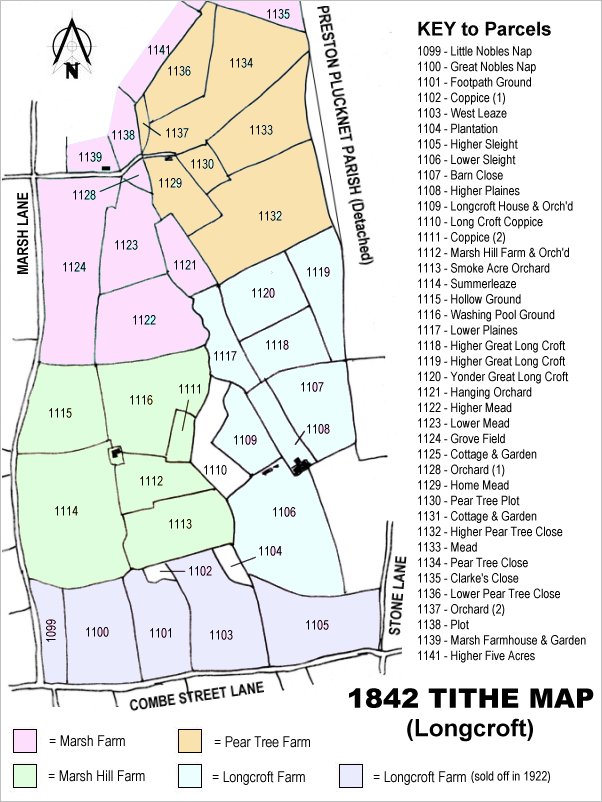Little Nobles Nap
Little Nobles Nap
A small field of Longcroft Farm
Little Nobles Nap (Parcel 1099) was a small field of Longcroft Farm.
It has been suggested (Goodchild) that the name Nobles Nap may have originated with reference to the annual rent of a Noble; current in England until the seventeenth century as a gold coin worth one third of a pound, or six shillings and eight pence. This would seem to make the rent inordinately expensive. It is therefore more likely that the name refers to a later owner called Noble. The 'nap' part comes from the Old English hnaep, for rising ground or the crest of a hill as, for instance, at Goar Knap.
Nobles Nap was originally one large field spanning both sides of Combe Street Lane and was originally part of the great Middle Field of Kingston Manor. It was later subdivided into five fields; two to the north of Combe Street Lane and three to the south. Those to the south being Nobles Nap (1401), Higher Nobles Nap (1096) and Lower Nobles Nap (1085). Those to the north of Combe Street Lane were Little Nobles Nap (Parcel 1099) and Great Nobles Nap (Parcel 1100).
The original large field called Nobles Nap was a site of burials of suicides, at least until the early nineteenth century. In its edition of 9 May 1814 the Sherborne Journal reported "A girl of the name of Sherstone, 20 years of age, servant to Mr Isaac Mullins, farmer of Yeovil (actually a glove manufacturer) put a period to her existence on Monday morning last, by taking a portion of arsenic; the Coroner's Jury sat on Saturday on the body, and brought in their verdict 'felo de se' (felon of himself). She was buried at the Cross Roads near the town. No cause is assigned for her committing this rash act, except a notice from her employer to quit his service for inattention to his afflicted mother." People who committed suicide were often buried at this crossroads. Another such place of interment was Corner Close, at the junction, or corner, of West Coker Road and Dorchester Road. An Act of 4 George IV (1823) directed that for the future a felo de se may be buried in the unconsecrated portion of a churchyard between the hours of nine and twelve at night and expressly states "without any stake being driven through the body". The driving of a stake through the body of a felon or suicide, was to prevent the ghost from "rising to the face of the earth again."
In 1816 Longcroft Farm, including Little Nobles Nap, was let to Henry Guppy, known as Harry. However, in April 1816, Harry was being held as a 'Prisoner for Debt' in the King's Bench Prison, Surrey, awaiting his case to be heard at the Guildhall, Westminster during the following month.
The 1846 Tithe Apportionment recorded that Little Nobles Nap was owned by Lord of Kingston Manor, William Jones Prowse, who had inherited huge land holdings in the area. The farm, at this time, was let to James Tucker. Little Nobles Nap was described as arable for growing crops and measured 3a 1r 15p.
During the 1860s, a Mr Sawtell was the tenant farmer. During the 1870s Robert Chard farmed Longcroft Farm, and during this period the farm was afflicted with a foot & mouth disease outbreak. In June 1879, Chard was declared a bankrupt. The next tenant farmer was William Hardy. By January 1908 Hardy had died and was followed, certainly between 1910 and 1921, by Herbert James Pearce.
During the early 1920s Longcroft Farm went through a series of auction sales and sales by private treaty. Little Nobles Nap (Parcel 1099) was sold off separately from the farm.
Little Nobles Nap (Parcel 1099) was bounded on the south by Mudford Road, to the west by Marsh Lane, to the north by Summerleaze (Parcel 1114) and to the east by Great Nobles Nap (Parcel 1100).
Today, the western and southern edges are occupied by modern housing bounding Marsh Lane and Mudford Road.
For details on historic land measurement (ie acres, roods and perches) click here.
Map

Each farm has
(or will have)
its own page -
click here.
Each Parcel of
land has (or
will have) its
own page -
click here.